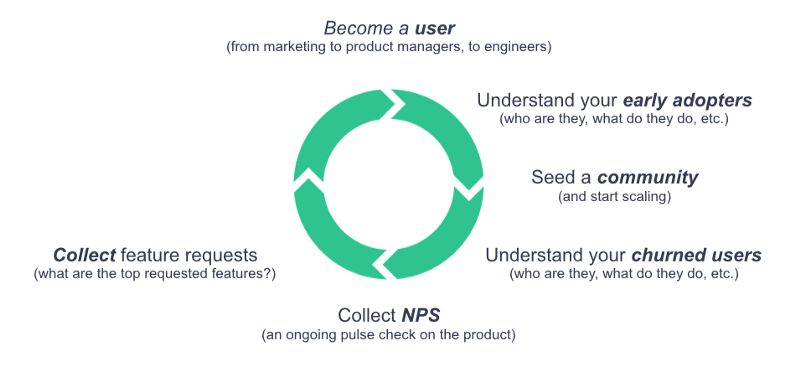The Complete Guide to Building a Framework for Customer Empathy [Part 3]
De complete gids voor het bouwen van een kader voor klantentimatie [deel 3]
Dit is deel 3 van een reeks uit drie delen. Controleer Deel 1 en Deel 2 .


Afgelopen week hebben we 4 extra stappen van het Customer Empathy Framework besproken. Voor dit laatste deel gaan we de lus sluiten en de laatste 3 stappen behandelen. Ben je klaar?
Stap 6: verzamel functieverzoeken
Als de zesde stap wilt u uw gebruikers toestaan deel te nemen aan de routekaart voor producten. Als er iets ontbreekt in het product, kunt u de gebruikers laten stemmen voor wat ze graag als volgende willen zien. Je zou dat in het openbaar kunnen doen, en hier is waarom.

There isn’t anything new about asking users for improvements and features, but what’s different here is that we’re doing it in the open and letting the community vote for the features they would like to see. This can help drive loyalty by showing your users that you are listening publicly. Once again, it’s an easy way to surface the most requested features to the entire organization.
At Adobe, we have been using Get Satisfaction and we are now adopting Uservoice.com for all of our products. For instance, you can see our users voting for the features they want for XD at adobexd.uservoice.com:

Or Spark at adobespark.uservoice.com:
For each request a user logs, you can respond and an email will be sent to all the users who voted for it or added comments. This is a great way to keep your users informed about the implementation of a feature or ask for more details, so this is a valuable tool for re-engagement too:
Uservoice provides a great mobile SDK too, enabling users to vote and request features on their device seamlessly and without being redirected to a website:
Now, you might ask “what’s the difference between this and a public backlog?" This gets really powerful when you start segmenting the requests posted on Uservoice by user engagement and NPS scores. You can rank the feature request by example user types: Very engaged, Casual User, or Churning. You can also rank them based on NPS scores and prioritize requests based on specific attributes. Uservoice calls this Custom Traits.
If a lot of churned users are asking for a feature, there might be an opportunity to add this feature to win these users back if you believe the users are in your target audience. Similarly, if a feature is being requested by your top paid users, with a decreasing NPS score, this might be something worth looking into before it becomes a reason for them to stop paying for your product. Finally, if a user is requesting a feature through an NPS comment, redirect that user to vote for it on Uservoice.
Step 7: FaceTime with your users
When was the last time you watched your users use your product? All the things we have covered so far are mostly digital interactions, but you also need face time with your users in order to observe them and talk to them.
With all the great tools accessible today, this might not sound so important, but it is essential. You can start with a monthly cadence of interviews. When you spend time with your users, you want to break it into three groups:
There are various services for running recorded user tests. Usertesting.com is one we have been using successfully, but it is missing live feedback. Getting a video recording is great for scaling, but you also need that live conversation to really ask the why and bounce off moments of pause, hesitations and even detect potential issues from the body language when people experience your product.
Usertesting recently introduced Live Conversation to enable such a research and that’s great news, but you also want to get out of the office and visit your customers in their local environment. Why?
You will spot things you would never have seen if they came to your office. Terrible internet speed that causes your product to be slow, people working outside with environmental noise that are preventing the user from hearing some instructions, etc. These are variables your users might forget to mention or have even developed workarounds and now take for the norm. You should be there with them to spot these things share your learnings/observations with your entire organization.
Finally, you want to reverse things and have your team present to your users what they are working on and what’s coming to the product in the future, let’s see how this works.
Step 8: Community summit
The last step is a 1-day outline or in-person conference where, in the morning, users can present how they use your product to the entire organization, and, in the afternoon, the team can present the product roadmap. It is critical to have as many people from the organization attend this event including senior leadership. Once again, having designers, engineers, and QEs hear live feedback from real users will have a huge impact on the team morale and ultimately make the product better.
For this, you might want to have different types of users there from very active to less active to churning. Historically, we have not done that, but have instead focused on our most active users to make this event more of a Community Summit. There is no silver bullet here. Experiment with various configurations. The key is to spend time as a team together with your users talking to you and your team sharing the vision for the product with them.
If you have made it to this point, you are definitely passionate about your product, your team and your customers, so kudos to you! Let’s summarize what we have covered.
Source: blog.growthhackers.com

